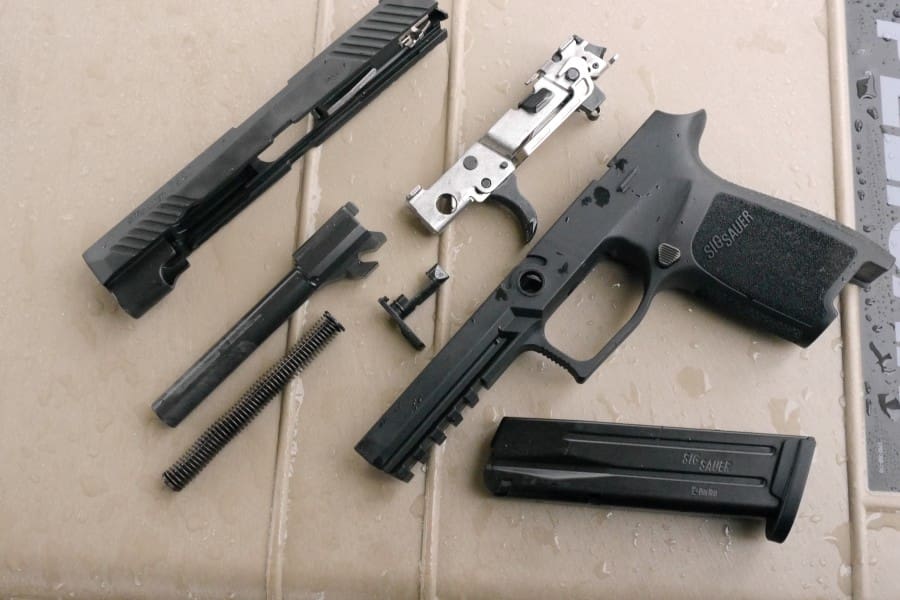Back in 2017, not long after SIG SAUER won the Army’s modular handgun system competition, Steyr Arms sued SIG over their P250 and P320 modular designs. The lawsuit claimed that SIG infringed on Steyr’s 2001 “plastic housing and multifunction metal part removably mounted” design patent.
Basically, the Austrian gun maker claimed that an internal metal chassis surrounded by a polymer grip module — the basis for SIG’s pistol designs in the P250 and P320 — is protected under their patent.

Now, however, a court has disagreed. In a summary judgement dismissal, a US District Court judge has ruled that SIG’s pistols do not violate Steyr’s intellectual property. The case would have gone to trial on May 5.
Here’s a press release from SIG . . .
SIG SAUER, Inc., a leading provider of firearms, optics, ammunition, suppressors, and training is pleased to officially announce the company has prevailed in the patent infringement lawsuit from Steyr Arms in the U.S. District Court for the District of New Hampshire. Judge Joseph DiClerico, Jr. granted SIG SAUER’s motion for summary judgment, finding that SIG SAUER did not infringe Steyr’s patents, and dismissed all motions.
Tom Taylor, Chief Marketing Officer, and Executive Vice President, Commercial Sales made the following statement:“We are extremely pleased with this ruling in favor of the SIG SAUER P320, the world’s most innovative handgun, and the SIG SAUER P250, which introduced modularity to the firearms market. The state-of-the-art SIG SAUER P320 is one of the most sought after firearms on the market, with its unmatched modularity, unprecedented accuracy, and uncompromising reliability. It has been chosen by all branches of the U.S. Military, as well as other domestic and global law enforcement agencies, and military units around the world. The P320 has truly redefined the modern handgun, and we are proud to have the years of extensive research and engineering that went into its design reaffirmed through this judgement.”





Now, I know little of the intricacies of patent law, but didn’t Styer have a similar concept in the late 70’s with their modular fire control group for their ‘bullpup’ AUG?
That horse has been long gone from the barn…
Geoff, you’re on track. In the AUG, the “fire control” group doesn’t contain the trigger and it’s not a serialized part. Very similar to the modern FN P-90.
It makes for seriously easy cleaning.
Modular fire control group? Like in the SKS?
Mauser had a removable FCU in the C96.
This case never had merit.
Question is, will they appeal the ruling, and claim bias on the basis of the military’s contract with sig. It wouldn’t be the first time.
Ding ding. This was simply .gov not wanting deliveries of the new sidearm interrupted. Anyone that is honest and objective can’t read the Steyr patent and not see Sig’s infringement. For anyone that cares to read it. https://patents.google.com/patent/US6260301
I won’t say that I know enough about patent law to make that claim but I doubt there is any way that the court would find against the military’s new handgun maker.
They’re claiming that putting a single assembly into a plastic shell and pinning it in place is novel… I wouldn’t try that argument, but that’s patent law for you.
I’m going to disagree on the obvious infringement. With patents, you can’t patent obvious solutions. You also can’t be infringing if you, in fact, hold a patent for what you made. When you have two similar patents, either the patent office screwed up and you suffer the consequences, or what is patented is what is unique between them. And currently, prior to this suit being filed, the US moved form a prior art defense methodology to a first to file wins methodology for settling this stuff.
The steyer patent, in saying how they aren’t ripping off glock, lists the defining characteristics.
1) It’s a chassis housed inside a housing.
2) it is fitted with all moving parts prior to being installed in the plastic housing. That implies the barrel (and from the looks of the drawing and the lockup, even the recoil spring)
3) Is secured by a pin up front that functions as the takedown lever.
4) Is secured by a tab in the back.
5) Has bits that function as slide rails.
6) “In the case of a pistol having a barrel which can be locked in the barrel slide, the invention achieves a further simplification in that the control means for locking are formed on the multifunction part. ”
This patent was granted in 1999 in the US. It was granted July 17 2001.
https://patents.google.com/patent/US6260301
Sig on the other hand has a patent too. Where
1) it is chassis housed in a housing.
2) It is fitted with a pin up front that functions as the takedown lever.
3) It is secured in the rear by a “form fitting means” i.e. the shape of the chassis interlocks with the housing. (this by the way covers the notion of a tab locking into the palstic mold).
4) has bits that function as slide rails.
5) The housing is used to contain and operate the recoil spring.
This patent was applied for in the US in 1999. It was granted may 22, 2001. https://patents.google.com/patent/US6234059
The Sig patent could be viewed as wholly a subset of the steyer patent except for the fact that it goes into other aspects of the firearm. Since sig would win the first to file argument, what you are left with are the bits that are unique and non-obvious.
The bits that fall into that area are that the barrel locks up on the chassis, and that ALL the moving bits can be fitted to the chassis outside of the housing. The latter is only possible because of the former. The sig p320 does not permit this. Everything that is not that overlaps with their patent where they were the first to file.
Not at all true. I’m copying in my comment from below here for your convenience. Basically, Steyr made a fundamental mistake in constructing their patents, namely making a means-plus-function claim. SIG was able to accomplish the same funciton through a different means, making it a non-infringing design which is not covered by Steyr’s patent, and so the judge dismissed the case. Original comment:
For the curious, the court’s rejection of Steyr’s patent infringement claims seems to hinge around the following portion of Steyr’s patent:
“…the multifunction metal part includes control means for locking said barrel in the barrel slide”
(The “multifunciton metal part” is how Steyr refers to their modular metal trigger housing/fire control group in the language of the patent)
Since the SIG design uses a separate pin for locking the barrel and the barrel slide (i.e. a separate part, not part of the “multifunciton metal part”) and since Steyr even acknowledges this in the language of their lawsuit (“Lastly, the frame assembly includes control means in the form of a pin for locking the barrel in the barrel slide (Exhibit C, pp. 62 and 63).”) the judge ruled that there was no patent infringment:
““Because the accused pistols do not include a bridge that is an integral, inseparable part of the one-piece multifunction metal part, they do not literally infringe Claim 1 of the ‘301 Patent,” DiClerico wrote
I have a Sig P250 full size in .45 that I bought at a gun show several years back (yeah, I did a BGC), it’s a solid pistol that gets a bad rap by some. Outside of the looooong DAO trigger pull, it’s an accurate shooter and reliable. The trigger pull is comparable (to me, anyway) to shooting a big bore revolver, once you get used to it can shoot well. But I never bought it intending to swap out barrels or make it a 9mm or .40 (never) or whatever. While I do see why that would be appealing to some, if I want those other calibers, I get them. I’d rather have more weapons than one that does everything, multiples of them, but that’s just me. I do like the way the full-sized Sig feels in the hand, it rings the steel and is robust. I don’t intend to ever get rid of it, I like shooting it. It led me to the 1911s and my current passion. Yeah. One time at band camp….
The .45 “modular” trigger assembly is not compatible with the smaller 9mm/.40. To utilize 9mm/.40 magazines you need a 9mm/.40 trigger assembly module.
Not true with the p250. Same FCU for .45acp -.380acp
Nope.
Aside from the legal aspects, the Steyr was only partially modular. Removing the trigger assembly/group required that you simultaneously capture 2 (2 very little, easily launched) springs and their associated parts…don’t even think about this in the field.
For the curious, the court’s rejection of Steyr’s patent infringement claims seems to hinge around the following portion of Steyr’s patent:
“…the multifunction metal part includes control means for locking said barrel in the barrel slide”
(The “multifunciton metal part” is how Steyr refers to their modular metal trigger housing/fire control group in the language of the patent)
Since the SIG design uses a separate pin for locking the barrel and the barrel slide (i.e. a separate part, not part of the “multifunciton metal part”) and since Steyr even acknowledges this in the language of their lawsuit (“Lastly, the frame assembly includes control means in the form of a pin for locking the barrel in the barrel slide (Exhibit C, pp. 62 and 63).”) the judge ruled that there was no patent infringment:
““Because the accused pistols do not include a bridge that is an integral, inseparable part of the one-piece multifunction metal part, they do not literally infringe Claim 1 of the ‘301 Patent,” DiClerico wrote.”
To me it’s like GE trying to sue me for manufacturing a new toaster. Sure, it “has slots for the purpose of browning slices of bread,” but that’s no longer novel. Sig is far from the only gun manufacturer with a design somewhat similar to the Steyr, but the difference is in being novel. Seriously, what would happen if Glock decided it was worth chasing patent infringement suits for “injection molded pistol frames.” It wouldn’t fly, because it’s not novel enough to be of consequence. This is why trigger geometry or new lockup systems or the like are where patents matter. Hell, where would the Browning family be if they got paid on every pistol made with the “Browning lockup” design? Exactly.
Comments are closed.